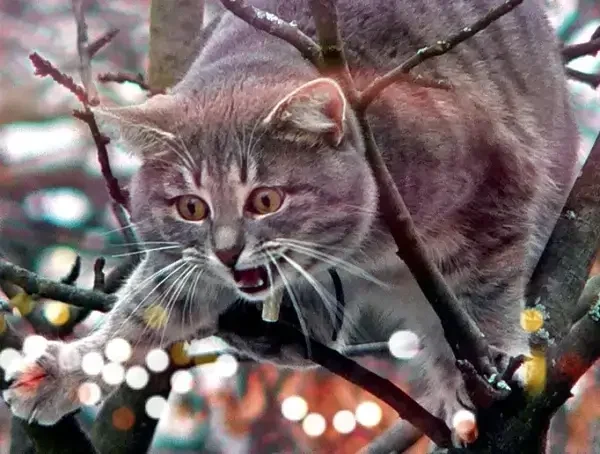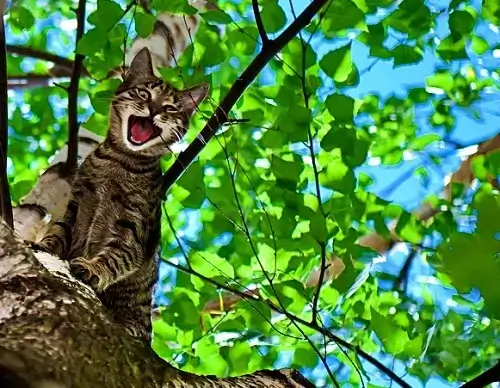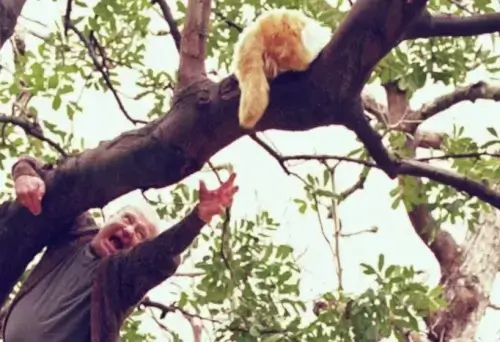Cat Stuck. The very definition of grace and agility, are masters of vertical movement. Cats navigate furniture with ease, pivot between delicate objects like professional ballet dancers, and scale curtains with the prowess of circus acrobats.
Yet, this primal urge for hunting and playing that drives them upward often leads to a puzzling and perplexing predicament: getting hopelessly stuck in a tree.
Why does a creature capable of twisting its body mid-air to land perfectly on all four paws, even after a substantial fall, suddenly lose its nerve and become paralyzed on a branch?
This common phenomenon is a fascinating intersection of anatomy, physics, instinct, and psychology.
The narrative of a ‘stuck cat’ is centuries old, an enduring image in cartoons and folklore, yet the scientific and behavioral reasons behind it are often misunderstood.
To truly appreciate why descending poses such a challenge, we must first examine the powerful motivations that propel a cat to such dizzying heights.
Cat Stuck, Duel of Instincts.
Why Cats Climb in the First Place.
A cat’s motivation for climbing trees generally falls into two conflicting categories, representing both ends of the predatory spectrum: the hunter and the hunted.
The Call of the Predator.
At their core, cats are born hunters. The fierce, instinctual drive to pursue prey can lead them to chase a bird, a squirrel, or even a wind-blown leaf high into the canopy without a second thought for the descent.
The elevated branches offer a perfect vantage point, allowing the cat to survey its territory and calculate its next move. Height provides a sense of security and invulnerability an isolated oasis where even the most vigilant predator feels safe from ground-level disturbances.
The climbing itself is part of the fun, engaging their bodies and minds in a thrilling, vertical game of pursuit.
The Sanctuary from Danger.
More frequently, cats ascend trees as a means of escape. A sudden loud noise, the pursuit of an aggressive dog, or the sighting of an unexpected threat can instantly switch a cat’s reaction from elegant stealth to panicked flight. In such a scenario, a tree is an immediate and effective sanctuary.
The cat intuitively understands that height provides distance from threats at ground level. Driven by pure survival instinct, they seek vertical refuge as a quick, decisive move to save themselves.
Simple Curiosity and Play.
Beyond survival and hunting, cats, particularly younger or more adventurous individuals, often climb purely for exploration and play.
A tree is, to them, a colossal, textured gymnasium and an oversized, stimulating scratching post. The act of ascending stretches their bodies, strengthens their muscles, and engages their senses a pure, exhilarating joy.
It is the adrenaline rush of movement, the delight in discovering “what’s up there?”
However, it is this very joy of the climb that leads to the stark realization that the mechanics for going up are radically different from those required for coming down.
The Anatomical Enigma.
The Physics of Feline Claws.
The primary reason cats get stuck is, quite simply, their anatomy. The very design that makes their claws perfect for ascending is what makes them obstacles for descending.
The Perfect Hook, the Poor Brake.
A cat’s claws are sharp, strong, and significantly curved inward. This curvature forms an ideal hook that catches the tree bark, providing maximum traction and pull when moving upwards.
They function like miniature grappling hooks, pulling the body to the next hold. However, in order to descend head-first, as squirrels or raccoons do, those same claws would need to be able to grip and push against the bark in a downward direction.
Due to their inward curve, they cannot do this effectively, causing the cat’s paws to slip and slide, leading to a terrifying loss of control.
The Limitation of the Ankle Joint.
Crucially, domestic cats lack the necessary hyper-mobility in their ankle joints to rotate their hind feet 180 degrees.
This specific anatomical adaptation is present in expert climbers like squirrels and the arboreal Margay cat.
This rotation allows those animals to turn their hind claws backward, pointing down the trunk to act as brakes and anchors during a head-first descent.
The domestic cat cannot achieve this, meaning a head-first descent is practically impossible without the high risk of a dangerous, uncontrolled fall.
The Coordination Challenge of Backing Down.
Theoretically, a cat can climb down backward, tail-first, a posture that allows the curved claws to work in the correct gripping direction.
However, this movement is highly unnatural for a feline. It requires complex coordination of the front and hind limbs and, most importantly, necessitates moving without being able to see what they are gripping onto or where they are stepping.
A cat’s brain, programmed for controlled, sight-based movement, often flags this blind descent as a red-alert risk.
In daily life, cats rarely practice a deliberate climb-down; they nearly always jump from low heights. When a cat is too high to safely jump and cannot master the coordination required to back down, they are effectively stranded.
Getting up was a rush of instinct; getting down becomes an existential moment of stress and paralysis.
The Psychological Barrier.
Fear, Fatigue, and Panic.
Sometimes, a cat is not physically stuck but psychologically paralyzed. Height-Induced Stress. The physical difficulties are compounded by panic and fear.
If a cat was chased up the tree, or if they are an indoor cat unaccustomed to the outdoor world, their terror of the height, unfamiliar noises, and ground-level threats can be so overwhelming that they enter a state of freeze and refuse to attempt any movement, even if a physical path exists.
Their instinct is to grip the branch immovably, waiting for the danger to pass. Compounded by fear, exhaustion from sustained stress, and dehydration, their ability to think clearly and attempt the difficult backward descent rapidly diminishes.
This highlights a critical reminder of the hazards of allowing cats to roam unsupervised, which frequently exposes them to life-threatening situations.
The Rescue Mission.
What to Do When a Cat is Stranded.
When a cat is stuck, the owner’s reaction is crucial. Calmness is the first step toward a successful rescue.
1. Maintain Calm and Presence: Cats are highly attuned to human emotions. Your panic will only exacerbate the cat’s terror. Sit or stand quietly near the base of the tree and speak to the cat in a calm, low, and reassuring voice.
They need to perceive your presence as a sign that the danger below has passed.
2. Engage the Power of Scent and Food: A cat’s sense of smell is a powerful motivator, capable of overriding fear. Place a bowl of their favorite, highly odorous food wet food, perhaps slightly warmed to enhance the aroma directly beneath the tree.
Sit quietly nearby, allowing the scent to overcome their fear and convince them that the journey down is worth the risk. Many cats, once hunger and comfort override their panic, will find a way down.
3. Create an Easier Route (The Ramp Strategy): If the cat is at a reachable height, you can significantly ease the descent by providing an alternative to the vertical trunk. Prop a long, sturdy board or a stable ladder against the tree at a gentle angle.
This creates a safer ramp they can “slide” down. Since the surface is less vertical, it reduces the need for the difficult backward-climb and allows the cat to use gravity more safely. After setting up the ramp, step away. A cat often feels safer descending when they perceive they are unobserved.
4. Call the Professionals: If the cat is extremely high up (over 30-40 feet), if the weather is turning inclement, or if the cat has been up there for more than 24 hours, it is time to seek professional help. In many countries, there are specialized “tree cat rescue” groups (often arborists or climbers) equipped with the necessary safety gear and expertise.
In other areas, the local fire department or tree removal service may be the appropriate contact. They possess the knowledge and equipment to ensure a safe recovery for both the feline and the rescuer.
Avoid Unnecessary Risks.
Unless you have professional climbing experience and safety gear, never attempt to climb the tree yourself. A terrified cat, reacting out of pure instinct, can inflict serious scratches or bites, and a fall from a height can result in severe injury for the owner. Your safety is paramount, and panicking will only frighten the cat more.
Cats are not cowards; they are creatures biologically unsuited for a specific type of controlled vertical retreat. They embody agility and flexibility, daring to go where other ground-dwellers cannot.
It is in this courage and their unique, upward-focused anatomy that the answer lies. Cats get stuck because they are perfectly engineered to move forward and up, not backward and down.
Even the most successful mountaineers occasionally need a helping hand to return safely to solid ground.
Have a Great Day!




